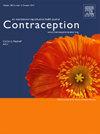Tennessee Medicaid patient immediate postpartum long-acting reversible contraception utilization
IF 2.3
2区 医学
Q1 OBSTETRICS & GYNECOLOGY
引用次数: 0
Abstract
Objectives
To understand immediate postpartum long-acting reversible contraception (IPP LARC) desire and utilization trends among publicly insured patients delivering at one academic hospital in a state with health care barriers and high short-interval birth rates.
Study design
We conducted a retrospective cohort study of electronic delivery records between March 2018 and June 2023 for publicly insured patients. Patient demographics, IPP LARC desire and utilization trends were compared using χ2 or Fisher exact tests. Binary logistic regression explored the relationship between IPP LARC utilization and demographics. Multivariable logistic regression was performed on all statistically significant variables.
Results
Analysis included 10,472 delivery encounters; 2459 (23.5%) requested IPP LARC on admission and 464 (4.4%) changed contraception to IPP LARC after admission. Among those obtaining IPP LARC (n = 2523, 24.1%), 1224 (48.5%) selected arm implants and 1299 selected intrauterine devices (IUDs). Patients who self-reported as non-Hispanic Black and non-Hispanic Other or multiple races utilized IPP LARC less (adjusted Odds Ratio (aOR)=0.84, 95% CI: 0.72–0.98, aOR=0.68, CI 95%: 0.48–0.97, respectively). Patients with cesarean delivery (aOR=1.45, 95% CI: 1.31–1.61) or inadequate prenatal care (aOR=1.54, CI 95%: 1.35–1.75) were more likely to utilize IPP LARC. Maternal age and years of education were inversely associated with utilization. Primiparous patients were less likely to utilize IPP LARC.
Conclusions
Long-acting reversible contraception (LARC) utilization was 24.1% during the immediate postpartum period; higher than the 11% nationally reported interval LARC use among publicly insured patients. Understanding the demographics of those desiring IPP LARC could highlight accessibility gaps. The impact of IPP LARC utilization on rates of short-interval birth is being evaluated.
Implications
Understanding the demographics of IPP LARC utilizers may contribute to understanding accessibility gaps and facilitate discernment of factors impacting patient initiation. Evidence suggests that comprehensive contraception access during delivery admission is feasible, patient-desired, and essential.
田纳西州医疗补助患者产后立即使用长效可逆避孕药的情况。
目的了解在一个存在医疗障碍和短间隔生育率较高的州的一家学术医院分娩的公共保险患者对产后立即长效可逆避孕药(IPP LARC)的渴望和使用趋势:我们对 2018 年 3 月至 2023 年 6 月期间公共保险患者的电子分娩记录进行了一项回顾性队列研究。使用卡方检验或费雪精确检验比较了患者的人口统计学特征、IPP LARC意愿和使用趋势。二元逻辑回归探讨了 IPP LARC 利用率与人口统计学之间的关系。对所有具有统计学意义的变量进行了多变量逻辑回归:分析包括 10,472 次分娩;2,459 人(23.5%)在入院时要求使用 IPP LARC,464 人(4.4%)在入院后将避孕措施改为 IPP LARC。在获得 IPP LARC 的患者(2523 人,24.1%)中,1224 人(48.5%)选择了臂植入,1299 人选择了宫内节育器。自我报告为非西班牙裔黑人和非西班牙裔其他或多种族的患者使用 IPP LARC 的比例较低(aOR=0.84,95% CI:0.72-0.98;aOR=0.68,95% CI:0.48-0.97)。剖宫产(aOR=1.45,95% CI:1.31-1.61)或产前护理不足(aOR=1.54,CI 95%:1.35-1.75)的患者更有可能使用 IPP LARC。产妇年龄和受教育年限与使用率成反比。初产妇使用 IPP LARC 的可能性较低:产后立即使用 LARC 的比例为 24.1%;高于全国报告的公共保险患者间隔使用 LARC 的 11%。了解需要 IPP LARC 的人群的人口统计学特征,可以凸显可及性方面的差距。目前正在评估使用 IPP LARC 对短间隔生育率的影响:资金来源:Organon IIS #60719 影响声明:了解 IPP LARC 使用者的人口统计学特征可能有助于了解可及性方面的差距,并有助于辨别影响患者开始使用的因素。有证据表明,在入院分娩期间提供综合避孕措施是可行的,也是患者所希望的,更是必不可少的。
本文章由计算机程序翻译,如有差异,请以英文原文为准。
求助全文
约1分钟内获得全文
求助全文
来源期刊

Contraception
医学-妇产科学
CiteScore
4.70
自引率
17.20%
发文量
211
审稿时长
69 days
期刊介绍:
Contraception has an open access mirror journal Contraception: X, sharing the same aims and scope, editorial team, submission system and rigorous peer review.
The journal Contraception wishes to advance reproductive health through the rapid publication of the best and most interesting new scholarship regarding contraception and related fields such as abortion. The journal welcomes manuscripts from investigators working in the laboratory, clinical and social sciences, as well as public health and health professions education.
 求助内容:
求助内容: 应助结果提醒方式:
应助结果提醒方式:


